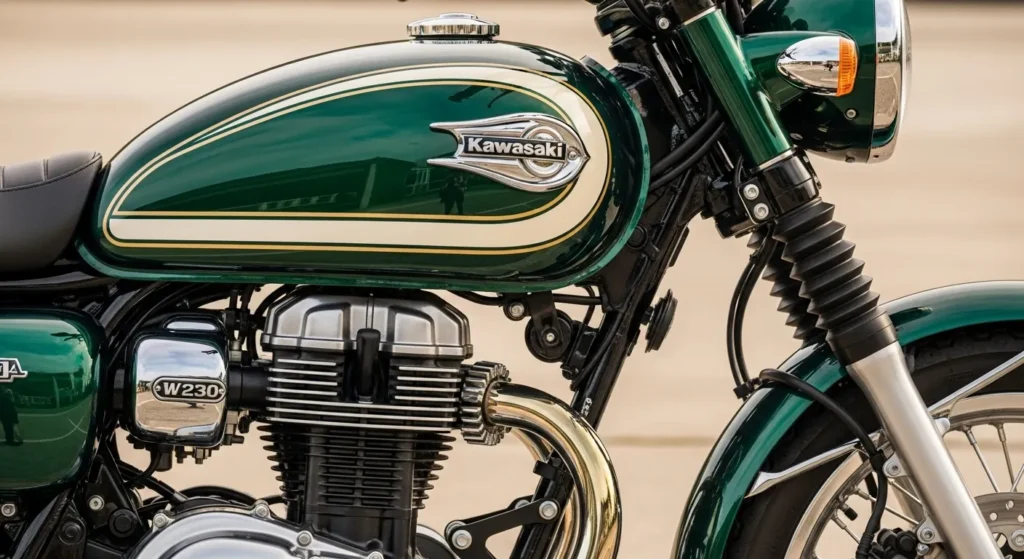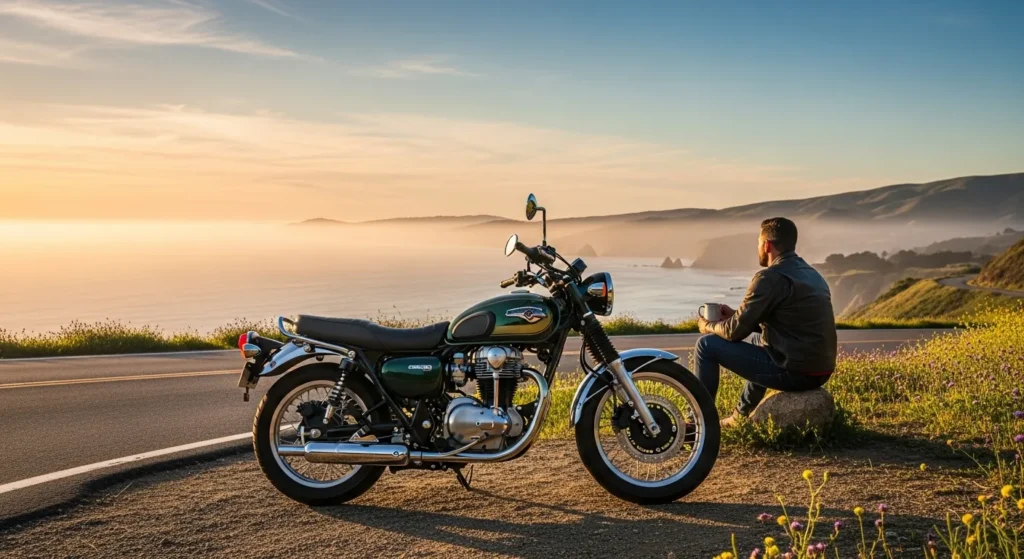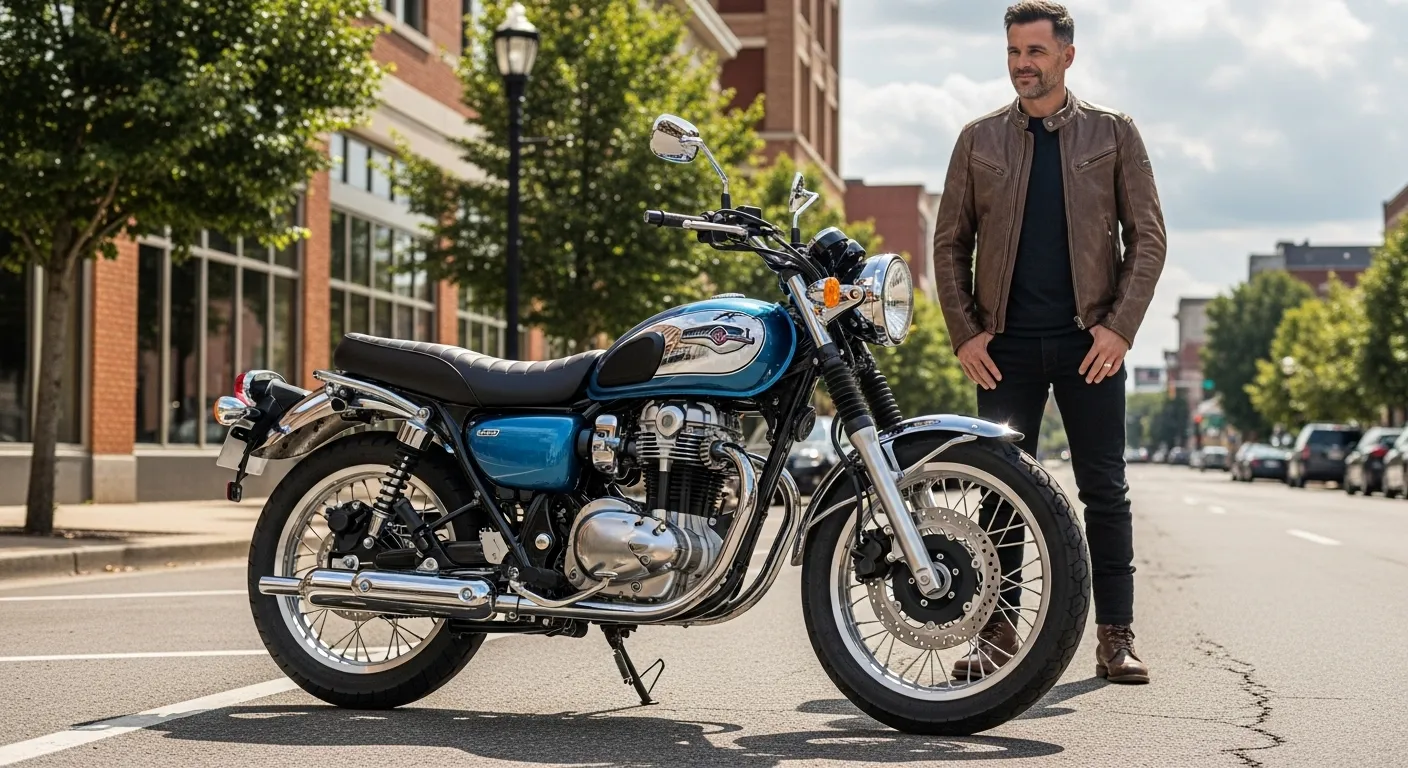In late 2024 and early 2025, Kawasaki quietly created a buzz with the unveiling of the 2025 W230 ABS, a new retro-styled standard bike targeted at riders wanting classic aesthetics at a more accessible scale. What makes this trending now is Kawasaki’s push to diversify its W series, bridging the gap between its flagship W800 and more entry-friendly models.
For U.S. riders eyeing a stylish commuter or weekend cruiser that’s approachable and not overly intimidating, the W230 represents a fresh direction. With social media teasers, early dealer listings, and enthusiast chatter, the 2025 W230 is becoming a topic of speculation among entry-level and retro-loving communities.
Add to it a backdrop where many riders are seeking lighter, lower-cost bikes (amid rising fuel / insurance costs and regulatory pressure on big displacements), and the W230’s timing looks smart.
Breaking Update & What Changed
Kawasaki has inserted the W230 as the smallest model in its W series, bringing classic styling to a 233 cc platform. The U.S. spec version is named 2025 W230 ABS, with standard ABS braking, a modern fuel-injection system, and retro styling cues all in one.
One clarifying update: while early speculation in forums pegged the W230 at about 18 horsepower, Kawasaki’s official specs suggest a more conservative tune (for U.S.) but emphasize smooth low-end torque.
Another notable point: U.S. dealer listings have already surfaced with tentative pricing and availability. For instance, a U.S. dealer shows the W230 ABS priced at $5,599 MSRP and a stock dealer listing at ~$4,781 in certain promos. Also, Kawasaki’s U.S. site already features the W230 in its retro model lineup.
Please take a look at this post as well: Honda WN7 Electric: Price, Specs & Why It’s Trending in the USA
Design, Tech & Features – What’s New

The W230’s styling is a clear homage to the 1965 650-W1 model, carrying over teardrop tank shapes, wire-spoked wheels, fork gaiters, chrome fenders, and retro badges. At the same time, it modernizes via LED lighting, an LCD readout (for odometer, trip, clock) built into twin analog dials, and updated ergonomics for everyday use.
On the tech side, the engine is a 233 cc air-cooled SOHC single cylinder (2-valve) with fuel injection (Kawasaki’s DFI) and a balancer to reduce vibration. Suspension is a 37 mm telescopic fork up front and twin shocks (preload adjustable) in the rear. Braking is via a front 265 mm disc, rear 220 mm disc, both with ABS.
It’s built around a semi-double cradle steel frame with a compact footprint. The ergonomics favor an upright posture, with a low seat height of about 29.3 in (745 mm) making it highly approachable for shorter riders.
Specs Table (2025 Kawasaki W230 ABS)
| Specification | Value / Detail |
|---|---|
| Engine | 233 cc, air-cooled, SOHC, single cylinder, 2 valves |
| Bore × Stroke | 67.0 mm × 66.0 mm |
| Compression Ratio | 9.0 :1 |
| Max Power | ~17 hp @ ~7,500 rpm (claimed) |
| Max Torque | ~19 N·m (14 lb-ft) @ ~5,800 rpm |
| Transmission | 6-speed, chain drive |
| Suspension | Front: 37 mm telescopic fork / Rear: twin shocks, 5-step preload |
| Brakes | Front: 265 mm disc, 2-piston caliper / Rear: 220 mm disc, 1-piston + ABS |
| Wheels / Tires | Front: 18″ (90/90-18) / Rear: 17″ (110/90-17) |
| Seat Height | 29.3 in (745 mm) |
| Wet / Curb Weight | ~315 lb (143 kg) approx. |
| Fuel Capacity | ~3.1–3.2 US gal (~12 L) |
What these numbers mean in day-to-day riding: The W230 isn’t a highway blitz machine, but its torque bias toward low and mid revs should make it pleasant for urban commuting, canyon carving, and casual cruising. Its light weight and compact size mean it should be nimble in traffic. The low seat height also broadens its appeal to a wider range of riders.
On the highway, expect speeds in the 70–80 mph range to be near its limit—manageable but with limited reserves. Fuel range should be acceptable for city runs and short weekend rides, though long-distance touring will be a stretch.
Please take a look at this post as well: Royal Enfield Electric Lineup Grows With Flying Flea FF-C6
Performance & Real-World Usage
Early test ride reports and first impressions (from media previews) highlight the W230’s friendly, smooth power delivery, rather than aggressive performance. The balancer and engine tuning do well to minimize harsh vibration, making it more comfortable for everyday use.
Its lightness and geometry help it feel “alive” in low-speed maneuvers, making it suitable for new riders or those wanting an easygoing classic ride. The suspension isn’t overly plush but is adequate for city roads, slight undulations, and backroads.
One caveat: at higher speeds or under load (two-up or with luggage), you’ll feel its limitations. It’s not designed for heavy touring — more for stylized commuting or relaxed weekend jaunts.
In real U.S. situations—say, navigating Los Angeles traffic or cruising State Route 1—the W230’s retro charm and ease of control will shine. On open highways or hilly terrain, it’ll require effort, patience, and moderate speed expectations.
How It Stacks Up vs Rivals
Compared to the Royal Enfield Classic 350 (a common benchmark in the retro / small displacement space), the W230 is lighter, likely more refined in execution, and packaged with ABS from day one. However, Enfield’s bigger displacement gives it an edge in top speed, torque and highway stability.
Against newer 250–400 cc retro / standard bikes (e.g. Honda CB300R, Yamaha SR400/500 variants, Kawasaki’s own KLX or dual-sport siblings), the W230’s advantage is its classic aesthetic, exclusivity, and Kawasaki’s brand heritage in the U.S. But it competes in a crowded field, and value perception will matter a lot.
Some early voices in forums and Reddit have criticized what they see as modest power / high price. For example, a Reddit thread labeled it “18 horsepower” and questioned whether the cost justifies the performance. That skepticism is something Kawasaki must counter with real-world satisfaction and dealer support.
Please take a look at this post as well: Affordable Harley-Davidson Sprint 2026 Set for U.S. Launch
Latest News & Developments
- Dealer Listings & Pricing: As of now, U.S. dealers are listing the W230 ABS at a $5,599 MSRP, with promotional pricing dipping under $5,000 in some regions.
- U.S. Website Presence: Kawasaki’s U.S. site already includes the W230 under its retro / classic lineups, hinting at committed support.
- Regional Color / Variant Info: North America’s confirmed color for the launch is Metallic Ocean Blue / Ebony.
- Community Reaction: Enthusiast forums and Reddit show a mix of excitement and skepticism—many laud the styling and approachability, while others foresee challenges around pricing and performance.
- No Major Recalls / Delays (yet): There are no reports currently of recalls or production setbacks. As a fresh launch, Kawasaki seems to be proceeding on schedule.
- Future Variants / Regions: Some media suggest that Kawasaki may later introduce variant models or expand the W230 (or its architecture) into related displacement ranges or regional markets.
Future Roadmap / Upcoming Versions

While Kawasaki hasn’t officially confirmed expansions, speculation is ripe that the W230 platform could spawn variants in future years—perhaps mildly tuned versions, café or scrambler derivatives, or even a Meguro S1 branding (which some regions already explore).
Given the W230’s role as an entry into the W-series, it’s plausible Kawasaki will roll out accessories, trim packages, or limited editions to keep it fresh. As riders adopt it, feedback may influence mid-cycle updates in throttle mapping, suspension, or even small power tweaks.
In the longer term, Kawasaki may extend the W line further downward (smaller cc) or upward (mild performance versions), providing a broader retro landscape.
Conclusion
The 2025 Kawasaki W230 ABS is an intriguing entry in the retro-standard sphere. Its strengths lie in classic styling, lightweight handling, accessible ergonomics, and Kawasaki’s brand backing. For urban riders, enthusiasts wanting a stylish commuter, or those stepping into retro bikes for the first time, it holds promise.
However, it’s not without compromises: modest power, highway limitations, and a price tag that invites scrutiny. The success of the W230 in the U.S. will hinge on how well Kawasaki supports it through dealer networks, real-world user satisfaction, and whether the riding public embraces charm over brute spec.
For early adopters, collectors, and riders seeking a visually rich, manageable motorcycle, the W230 offers a fresh option in 2025. For those chasing performance, larger displacement or alternate platforms may still be more practical.
If you like, I can also draft a U.S. buying guide / competitor comparison piece for the W230 to accompany this article — would you prefer that next?
